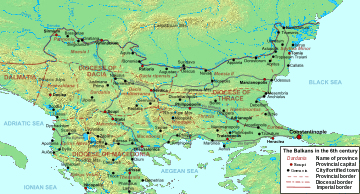Pannonia (Byzantine province)
| Pannonia Provincia Pannonia επαρχία Παννονία | |||||
| Province of the Byzantine Empire | |||||
| |||||
 | |||||
| Capital | Sirmium | ||||
| History | |||||
| - | Established | c. 510 | |||
| - | Avar conquest | 580s | |||
| Today part of | | ||||

Part of a series on the |
|---|
| History of Vojvodina |
 |
| Ancient |
| Middle Ages |
|
| Modern |
|
Pannonia was a Byzantine province, which existed in present-day Syrmia region of Serbia in the 6th century. Its capital was Sirmium (modern-day Sremska Mitrovica).
It differed significantly in its area from the Roman province of Pannonia, and it was subordinate to the Diocese of Dacia.
Geography
The province was located between the Danube river in the north-east and Sava river in the south. The western border of Byzantine Pannonia stretched approximately to the estuary or river Drina into Sava. Important cities in the area were Sirmium and Bassianae. Byzantine Pannonia bordered Byzantine province of Moesia Prima in the south and Avar Khaganate in the west, north and east.
History
Origins
Byzantine Pannonia was named after former Roman province of Pannonia, which included much larger territory. Byzantine province, in fact, included only small eastern part of historical Pannonia. In the 2nd century, original Roman province was divided into two provinces: Pannonia Inferior and Pannonia Superior. Subsequently, the area was divided into four provinces: Pannonia Prima, Pannonia Valeria, Pannonia Savia and Pannonia Secunda. Capital of Pannonia Secunda was Sirmium.
In the middle of the 5th century, territory of former Roman Pannonia was ceded to the Huns by Theodosius II, and after the death of Attila successively passed (entirely or partially) into the hands of the Ostrogoths, Lombards and Gepids.
A contract from 510 assigned most of the territory of former Roman Pannonia (including Sirmium) to Ostrogoths, while eastern part of present-day Syrmia region (which included the city of Bassianae) was assigned to the Byzantine Empire. In 536, Sirmium was placed under control of the Gepids. In 567, Avars defeated Gepids; Gepid king Cunimund escaped to Dacia, while Usdibad, who was in charge of the defense of Sirmium escaped to Constantinople and handed Sirmium to the Byzantine emperor. The Byzantine army then entered Sirmium and the city became the capital of the Byzantine province of Pannonia.
Under the Byzantine Empire
From 567 to 573, Byzantine Empire was in a war with the Avars, who aimed to conquer Byzantine Pannonia. Temporary truce was agreed in 573, but the war was resumed. Due to the fact that Byzantine-Persian war also started in this time, the Byzantine Empire was not able to defend Pannonia. The city of Sirmium was finally conqueredby the Avars in 582, thus marking end of Byzantine control of Pannonia.
Legacy
The Byzantine Empire re-established control over Pannonia in the 11th century, leading to the creation of the Theme of Sirmium to administer the region.
References
- Prof. Dr. Radmilo Petrović, Vojvodina - petnaest milenijuma kulturne istorije, Beograd, 2003.
- Dr Petar Milošević, Arheologija i istorija Sirmijuma, Novi Sad, 2001.